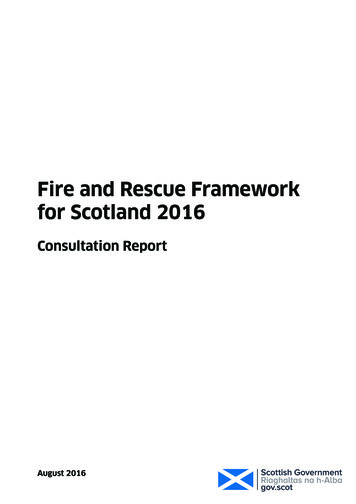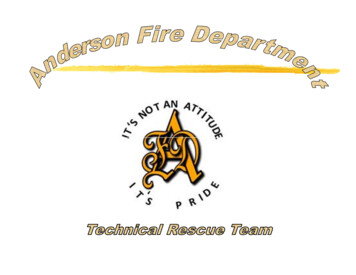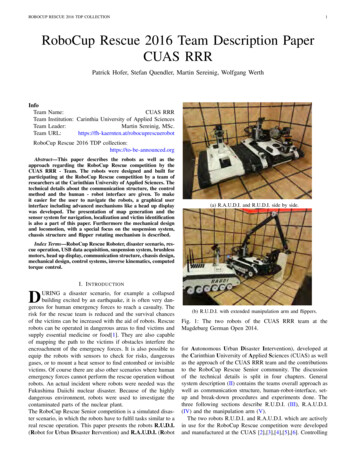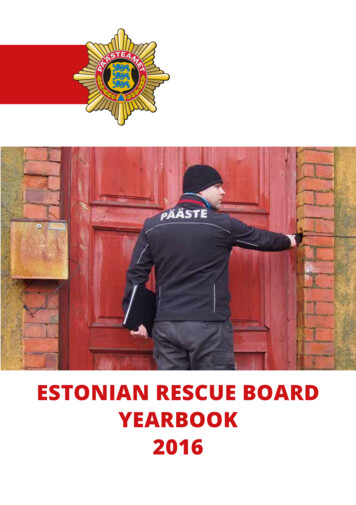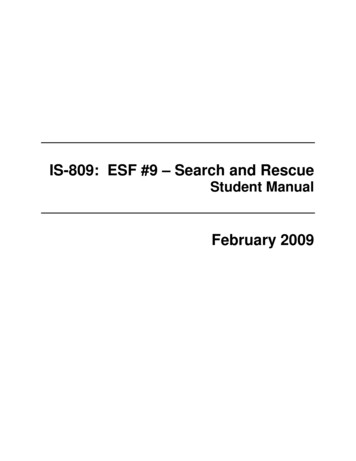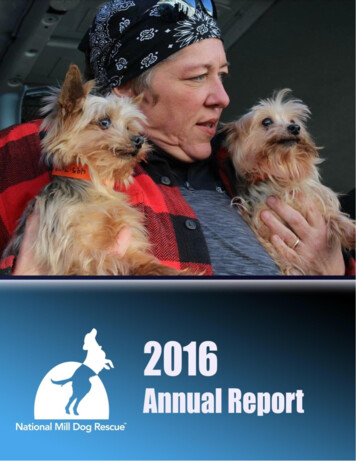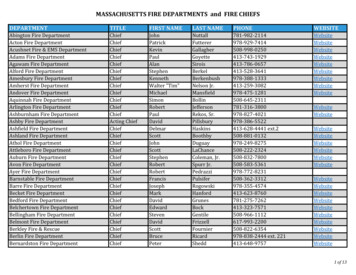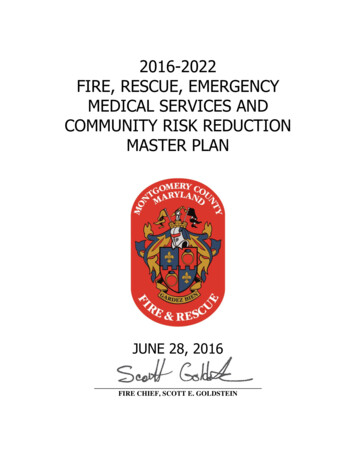
Transcription
2016-2022FIRE, RESCUE, EMERGENCYMEDICAL SERVICES ANDCOMMUNITY RISK REDUCTIONMASTER PLANJUNE 28, 2016FIRE CHIEF, SCOTT E. GOLDSTEIN
2016-2022 FIRE, RESCUE, EMERGENCY MEDICAL SERVICES,AND COMMUNITY RISK REDUCTION MASTER PLANii
2016-2022 FIRE, RESCUE, EMERGENCY MEDICAL SERVICES,AND COMMUNITY RISK REDUCTION MASTER PLANiii
2016-2022 FIRE, RESCUE, EMERGENCY MEDICAL SERVICES,AND COMMUNITY RISK REDUCTION MASTER PLANPREFACEThe purpose of this Fire, Rescue, Emergency Medical Services, and Community Risk ReductionMaster Plan is to set a forward-thinking, rational, and attainable blueprint for the continueddelivery of effective and efficient fire, rescue, emergency medical services, special operations,and community risk reduction services to meet the all-hazards mission of the MontgomeryCounty Fire and Rescue Service (MCFRS). The Plan guides the MCFRS in how best thedepartment can meet the needs and expectations of its customers and address the overall firerescue related risk present in the County.The primary focus of the Fire, Rescue, Emergency Medical Services, and Community RiskReduction Master Plan is our external customers - the residents and business owners ofMontgomery County as well as visitors to the County. Other external customers to which thisMaster Plan is focused include MCFRS' partners, including County departments and agencies,municipalities located in Montgomery County, private sector emergency service organizationsand utilities serving the County, and State and federal departments/agencies. Internal customersof the MCFRS to which this Plan is also focused include the career and volunteer serviceproviders, Local [Volunteer] Fire-Rescue Departments (LFRDs), Fire and Emergency ServicesCommission (FESC), International Association of Fire Fighters (IAFF) – Local 1664,Montgomery County Volunteer Fire and Rescue Association (MCVFRA), and fire-rescueresource groups that support the MCFRS.Unlike previous editions of the Fire, Rescue, Emergency Medical Services, and Community RiskReduction Master Plan which addressed 10-year time frames, this edition of the plan addresses a6-year time frame. There are two reasons for this change: 1) the County Fire Chief believed ashorter time frame was more appropriate due to the County’s evolving demographic, economicand political landscape impacting the Fire and Rescue Service; and 2) the advantage of bringingthe plan in alignment with the County’s Capital Improvements Program (CIP) which operates ona 6-year cycle; thus the master plan will align with the FY17-22 CIP. This 6-year approach ismeant to be permanent with respect to future editions of the Fire, Rescue, Emergency MedicalServices, and Community Risk Reduction Master Plan; for example, the next edition wouldcoincide with the FY23-28 CIP.The master plan reflects the FY2016 mini-restructuring of the MCFRS. The mini-restructuringresulted in five divisions that are based upon five primary themes: our people (Division ofHuman Resources), our infrastructure and support systems (Division of Support Services), ourmanagement of fiscal resources (Division of Fiscal Management), our emergency services(Division of Operations), and our volunteer services and outreach to the community (Division ofVolunteer & Community Services). As part of the mini-restructuring, various sections andfunctions have been moved to different or new divisions or to the Office of the Fire Chief. Themini-restructuring chart can be found in Appendix B.iv
2016-2022 FIRE, RESCUE, EMERGENCY MEDICAL SERVICES,AND COMMUNITY RISK REDUCTION MASTER PLANPREFACE (Continued)Considering that some readers of this Master Plan may not be familiar with the MontgomeryCounty Fire and Rescue Service, those readers are encouraged to review the list of acronyms aswell as the glossary before reading Sections 1-6.This Master Plan can also be viewed in its entirety online at www.mcfrs.org, and MCFRSpersonnel can access the plan on MCFRS QuickLinks.SPECIAL NOTEShortly before this master plan had been finalized and approved, the Fire Code Compliancefunction was transferred from MCFRS’ Office of the Fire Marshal to the Department ofPermitting Services (DPS), Building Division1, effective April 3, 2016. The primary purpose ofthe transfer was cost savings involving the consolidation of similar business processes for codeenforcement and compliance under a single department (i.e., DPS). Non-uniformed (“civilian”)fire code compliance staff was moved from MCFRS to a department staffed entirely by civilianemployees many of whom have code compliance responsibilities pertaining to buildingconstruction. Furthermore, the Fire Code Compliance function was reunited with functionspreviously administered by MCFRS’ Office of the Fire Marshal, including review ofarchitectural plans for fire code compliance and inspection of new construction, both of whichhad been transferred from MCFRS to DPS in 1994 and 2012, respectively.Prior to the transfer of Fire Code Compliance to DPS, a customer service agreement had beenforged between DPS and MCFRS outlining how the DPS Code Compliance Section willcontinue providing the same level of fire code support to MCFRS that the former Fire CodeCompliance Section had provided.It is important to note that the fire/explosive incident investigations and bomb response functionsprovided by the Fire and Explosives Investigation Section (formerly paired with Fire CodeCompliance under the Office of the Fire Marshal) will remain in MCFRS under the Division ofOperations, Special Operations Section.1In FY17, the DPS Code Compliance Section will become part of a new DPS organizational unit known as the FirePrevention and Code Compliance Division.v
2016-2022 FIRE, RESCUE, EMERGENCY MEDICAL SERVICES,AND COMMUNITY RISK REDUCTION MASTER PLANACKNOWLEDGEMENTSCounty Fire Chief Scott E. Goldstein acknowledges all individuals who contributed to thepreparation and review of the Fire, Rescue, Emergency Medical Services, and Community RiskReduction Master Plan, including those listed below. Contributors provided invaluable input,including written and verbal contributions to the various drafts, data and data analyses, GISsupport, technical expertise, comments on plan drafts, and related assistance.Plan Author: Scott Gutschick, Manager, Planning & Accreditation Section, MCFRSGIS Support: Sarah Ierley, GIS Manager, Planning & Accreditation Section, MCFRSData and IT Support:Po Kar Chu, IT Manager, MCFRSLucy Song, IT Specialist III, MCFRSJeff Feiertag, IT Training Coordinator, MCFRSPamela Zorich, Research Coordinator, Montgomery County Planning DepartmentOther MCFRS Contributors:[Former] County Fire Chief Steven E. Lohr (retired)Division Chiefs: Diane Zuspan, David Steckel, Alan Hinde, Stephen Jones, Dominic Del PozzoAssistant Chiefs: John Kinsley, John Dimitriadis, Edward Radcliffe, Michael Nelson, AdamJones, Barry Reid, Gary Cooper, Eric Houston, John Van Gieson, Maurice Witt, CharlesBailey, John GalloBattalion Chiefs: Pete Friedman, Kevin Frazier, Alan ButschMLS Managers: June Evans, Po Kar Chu, Pete Piringer, Rick Merck, Steve Lamphier, LeslieMaxam, Andy Olaciregui, Beth Anne NesseltDr. Roger Stone, MD, EMS Medical DirectorGeorge Giebel, Program Manager IIJoe Coyne, Administrative Specialist IIIBill Delaney, Program ManagerEmilie Crown, Program ManagerMCFRS Contractor Support:Demetrios “Jim” Vlassopoulos, MCFRS Accreditation ManagerJim Resnick, Program Manager, Senior Outreach and Educationvi
2016-2022 FIRE, RESCUE, EMERGENCY MEDICAL SERVICES,AND COMMUNITY RISK REDUCTION MASTER PLANACKNOWLEDGEMENTS (cont.)Fire and Emergency Services Commission:Chairperson: Kevin MaloneyCommissioners: Anita Powell, Ronald Ogens, Tony Coleman, Raymond Sanchez, MichaelKelley, Michael BurnsMontgomery County Volunteer Fire Rescue Association:Marcine Goodloe, PresidentEric Bernard, Executive DirectorInternational Association of Fire Fighters – Local 1664:Jeff Buddle, PresidentRegional Service Centers and Citizen Advisory Boards:Regional Service Center Directors: Catherine Matthews, Kenneth Hartman, Jewru Bandeh,Reemberto Rodriguez, Ana Lopez van Balen (former RSC Director)Citizen Advisory Boards (Five CABs associated with the five Regional Service Centers)MunicipalitiesCity of Rockville, Community Planning and Development Servicesvii
2016-2022 FIRE, RESCUE, EMERGENCY MEDICAL SERVICES,AND COMMUNITY RISK REDUCTION MASTER PLANTABLE OF CONTENTSCounty Council Resolution 18-546PrefaceAcknowledgementsTable of ContentsAcronymsGlossaryiiivviviiixivxviSECTION 1 – INTRODUCTION1-1BackgroundMaster Plan Purpose, Scope, and TimeframePlanning AssumptionsStatutory Requirement for Master Planning1994 (Original) Master Plan and Amendments2005-2015 Master Plan and UpdatesAnnual Strategic PlanPlan Amendments, Revisions and ReplacementLaws, Statutes, Standards, and Best PracticesIntegration of Fire-Rescue and Community/Municipal Master Plans1-21-21-31-51-51-71-81-81-91-16SECTION 2 - MCFRS ORGANIZATION AND PARTNERSHIPS2-1MCFRS Organizational Doctrine Vision Mission Guiding principles/values Goals and objectives2-22-22-22-32-3Organizational Structure Office of the Fire Chief Division of Operations Division of Human Resources Division of Fiscal Management Division of Support Services Division of Volunteer & Community Services Local Fire and Rescue Departments Fire and Emergency Services Commission Career and volunteer unions/bargaining units2-52-52-82-112-132-142-152-162-172-18viii
2016-2022 FIRE, RESCUE, EMERGENCY MEDICAL SERVICES,AND COMMUNITY RISK REDUCTION MASTER PLANMCFRS Personnel Career personnelo Career uniformed personnelo Career civilian personnel Volunteer personnel2-192-192-192-202-21MCFRS Partnerships Mutual aid partnerships Montgomery County departments and agencies Private sector organizations and utilities Municipalities in Montgomery County Metropolitan Washington Council of Governments State of Maryland Federal Government2-222-222-232-292-302-312-322-33SECTION 3 – FIRE DEPARTMENT ACCREDITATION3-1Overview of Fire Department Accreditation Description Accreditation benefits Agency commitment to the process3-23-23-43-5Commission on Fire Accreditation International (CFAI) CFAI mission CFAI model CFAI guidance publications Accreditation training Peer assessment3-53-53-63-63-73-7Accredited Agency Required Documents Self-Assessment Manual Community Risk Assessment - Standards of Cover Master/Strategic Plan3-83-83-93-10SECTION 4 – ALL-HAZARDS RISK ASSESSMENT & STANDARDS OF COVER 4-1Risk 4-24-24-64-7Risk DefinedAcceptable Level of RiskTarget Hazardsix
2016-2022 FIRE, RESCUE, EMERGENCY MEDICAL SERVICES,AND COMMUNITY RISK REDUCTION MASTER PLANFire-Rescue Risk Emergency medical risk Fire risk Hazardous materials risk Explosive/destructive device (bomb) risk Water/ice risk Technical rescue-related risk Aviation risk Terrorism risk Natural hazards risk Technological hazards risk Societal hazards Impact of Change on Risk and Service Demand Impact of Demographicso Populationo Race/ethnicityo Age and gendero Income and jobso Households and language spokeno Housing/building stock Impact of Developmento Development in progresso Planned developmento Limited developmento Planning in progress Impact of Mass Transit Development/Expansiono Purple Lineo Bus Rapid Transit Corridorso Corridor Cities 4-424-484-484-534-534-555-56Standards of Cover Critical tasks Staffing levels Response timeso First-arriving unit response timeso Effective Response Force response times4-574-574-584-584-594-60x
2016-2022 FIRE, RESCUE, EMERGENCY MEDICAL SERVICES,AND COMMUNITY RISK REDUCTION MASTER PLANSECTION 5 – ISSUES AND NEEDS5-1Preparedness/Readiness Operationso Emergency medical serviceso Fire suppressiono Special operations Apparatus Community outreach and public information Community Emergency Response Team (CERT)5-25-25-25-45-55-65-75-8Resource Deployment and Staffing Emergency medical services Fire suppression Special operations Staffingo Operational staffingo Administrative staffing5-85-85-95-105-105-105-11Planning and Assessment Planning Assessment5-115-115-14Infrastructure, Communications and IT Facilities Apparatus maintenance and replacement Equipment maintenance and replacement Emergency communications Information technology5-155-155-215-225-225-24Data Analysis and Application5-24Training and Health & Wellness Training Health & Wellness5-255-255-26Fiscal, Support Services and Human Resources Fiscal management Property and supply Human resources5-275-275-285-28Other Issues and Needs5-29xi
2016-2022 FIRE, RESCUE, EMERGENCY MEDICAL SERVICES,AND COMMUNITY RISK REDUCTION MASTER PLANSECTION 6 – INITIATIVES AND PRIORITIES6-1Preparedness/Readiness Operationso Emergency medical serviceso Fire suppression and heavy rescueo Special operations Apparatus Volunteer and Community Serviceso Community outreach and public informationo Community Emergency Response Team6-26-26-26-56-66-76-86-96-10Resource Deployment and Staffing Operations Emergency medical services Fire suppression Special operations Facilities6-116-116-126-136-136-14Planning and Assessment Planningo Strategic and long-range planningo Succession planningo Site evaluation/selectiono Land reservation/acquisition for stationso Geographic Information Systemo Planning & Accreditation Section staffing6-156-156-156-156-166-176-176-17 Assessmento Performance measures and dashboardso Performance appraisalo Accreditation complianceInfrastructure, Communications and IT Facilitieso New-additional stationso Station relocationso Station renovations, expansions and “rebuilds”o Other facility relocations, renovations and reuses Apparatus maintenance and replacement Equipment maintenance and replacement Emergency communications Information -246-256-266-266-28
2016-2022 FIRE, RESCUE, EMERGENCY MEDICAL SERVICES,AND COMMUNITY RISK REDUCTION MASTER PLANData Analysis and Application6-30Training and Health & Wellness Training Health and Wellness6-316-316-32Fiscal, Support Services and Human Resources Fiscal management Procurement invoicing Property and supply Human resources6-336-336-356-366-36Other Initiatives6-38APPENDICESAppendix A – Laws, Statutes and Standards Impacting MCFRSAppendix B – MCFRS Organizational Chart and Station Locations MapAppendix C – Highest Risk Level per Station AreaAppendix D – Incident Density MapsAppendix E – Demographic MapsAppendix F – Planned Mass Transit Network MapsAppendix G – 2022 Response Time BenchmarksAppendix H - Facility, Resource and Staffing InitiativesAppendix I – Quick Reference to 2016-2022 Initiatives and Prioritiesxiii
2016-2022 FIRE, RESCUE, EMERGENCY MEDICAL SERVICES,AND COMMUNITY RISK REDUCTION MASTER IAFFIECSAccreditation Center for ExcellenceAutomated external defibrillatorALS first responder apparatusAdvance Land Acquisition Revolving FundAdvanced life supportBureau of Alcohol, Tobacco, Firearms and ExplosivesBasic life supportComputer aided dispatch [system]Compressed-air foam systemCommunity Emergency Response TeamCommission on Fire Accreditation InternationalCapital Improvements ProgramCommission on Accreditation of Allied Health EducationProgramsCommittee of Accreditation of Educational Programs for theEmergency Medical Services ProfessionsCode of Maryland Administrative RegulationsCandidate Physical Ability TestCardio-pulmonary resuscitationCenter for Public Safety ExcellenceCommunity Risk Assessment – Standards of Cover [document]Cardiac Rescue Technician - IntermediateEmergency Operations CenterEmergency Management GroupEmergency medical servicesEmergency medical services transport [fee]Emergency Medical TechnicianElectronic Patient Care ReportingEffective response forceFederal Emergency Management AgencyFire and Emergency Services CommissionFire and Emergency Services Self-Assessment ManualFire-Rescue Occupational Medical SectionFire-Rescue Training AcademyFire Service Professional Qualifications BoardGeographic Information SystemInternational Association of Fire Fighters (Local 1664)Integrated Emergency Command Structurexiv
2016-2022 FIRE, RESCUE, EMERGENCY MEDICAL SERVICES,AND COMMUNITY RISK REDUCTION MASTER PSTARMSRRATSSOCSTEMIUASIUS&RWMDLocal Fire and Rescue DepartmentMontgomery County Fire and Rescue ServiceMass casualty incidentMontgomery County PoliceMontgomery County Public SchoolsMontgomery County Volunteer Fire and Rescue AssociationMaryland Emergency Management AgencyMaryland Fire and Rescue InstituteMaryland Institute for Emergency Medical Services SystemsMaryland Occupational Safety and HealthMaryland-National Capital Park and Planning CommissionMetropolitan Washington Council of GovernmentsNational Capital RegionNational Fire Protection AssociationOffice of Emergency Management and Homeland SecurityOccupational Safety and Health AdministrationPersonal injury collisionPublic Information OfficerPublic Safety Access PointPublic Safety Communications CenterPublic Safety HeadquartersPublic Safety Logistics [Facility]Public Safety Systems Modernization [Project]Public Safety Training AcademyRecord management systemRiver Rescue and Tactical Services [Team]Standards of coverST-segment elevation myocardial infarctionUrban Area Security InitiativeUrban search and rescueWeapons of mass destructionxv
2016-2022 FIRE, RESCUE, EMERGENCY MEDICAL SERVICES,AND COMMUNITY RISK REDUCTION MASTER PLANGLOSSARYAcceptable (or Unprotected) Risk - That risk which the jurisdiction (e.g., MontgomeryCounty) is willing to accept rather than provide the extraordinary amount of resourcesand programs required to eliminate, or nearly eliminate, all fire/rescue-related riskthroughout the jurisdiction.Accreditation - A comprehensive self-assessment and evaluation model that enablesorganizations to examine past, current, and future service levels and internal performanceand compare them to industry best-practices for the purpose of improved servicedelivery. [Source: CFAI]Accredited Agency Status – The status awarded to a fire-rescue agency that hassuccessfully completed the requirements for accreditation and has been granted thatstatus by the Board of Directors overseeing the process. To obtain Accredited AgencyStatus by the Commission for Fire Accreditation International, a fire-rescue agency mustbe granted that status by the CFAI Board of Directors.Advanced Life Support (ALS) – Advanced-level emergency medical services includingthe administering of controlled life-saving drugs; electrical therapy includingdefibrillation; advanced airway management including orotracheal and nasotrachealintubation; intravenous maintenance therapy, and other advanced-level life supportservices.Aerial Unit - A vehicle equipped with an aerial ladder, elevating platform, aerial ladderplatform, or water tower that is designed and equipped to support firefighting and rescueoperations by positioning and providing access for personnel, supporting the verticalmovement of equipment, providing continuous egress, and discharging water frompositions elevated from the ground. MCFRS deploys ladder trucks (e.g., tractor-drawnaerials, rear-mount aerials) and aerial towers.AFRA - Advanced life support First Responder Apparatus is any MCFRS unit other thanan ambulance, medic unit or ALS chase unit that has a paramedic and an ALS Kit onboard. The ALS provider(s) on board an AFRA can initiate ALS service to a patienthaving a life-threatening condition prior to arrival of an EMS transport unit.ALS Provider –Firefighter or EMS-provider trained and certified as a Paramedic orCardiac Rescue Technician-Intermediate (CRT-I).xvi
2016-2022 FIRE, RESCUE, EMERGENCY MEDICAL SERVICES,AND COMMUNITY RISK REDUCTION MASTER PLANALS Unit – A fire-rescue vehicle equipped with an ALS Kit and staffed by at least oneALS provider. An ALS unit may or may not have patient transport capabilities.Examples: medic unit, paramedic engine, paramedic truck, paramedic rescue squad, ALSchase unit, EMS Duty Officer.ALS Chase Unit – A fire-rescue unit (e.g., SUV) staffed by an ALS provider(occasionally two ALS providers) capable of providing advanced life support care butlacking patient transport capability.Ambulance - An emergency medical service unit that is equipped and staffed to providebasic life support services, including patient transport. An ambulance is staffed by aminimum of two personnel minimally trained at the EMT level.Apparatus - Fire-rescue vehicle(s) used for emergency response.Basic Life Support (BLS) – Basic-level emergency medical services including patientassessment; airway management; cardiopulmonary resuscitation (CPR); rescue breathing;use of automated external defibrillators (AEDs); treatment of contusions, puncturewounds, broken bones, sprains and strains; spinal immobilization; child delivery; andsimilar basic-level life support.Brush Truck – An all-wheel drive fire suppression unit specially equipped for fightingfires in brush, forest, grasslands, and croplands. Brush trucks are typically all-wheeldrive pickup trucks equipped with a small water tank, small diameter hose, andequipment for suppressing fires in terrain that larger apparatus cannot navigate.Cardiac Rescue Technician - Intermediate (CRT-I)2 – The State certification given toEMS providers who meet the minimum requirements for providing an intermediate levelof emergency medical services within the State of Maryland. Skills required of personnelcertified at the CRT-I level include all EMT skills, plus intravenous fluid administration,medication administration, external jugular cannulation, intraosseous cannulation,decompression thoracostomy, combitube, EKG monitoring, defibrillation/cardioversion,and endotracheal intubation. To become licensed at the CRT-I level, personnel mustsuccessfully complete the State’s CRT-I curriculum and written licensing exam.Community Risk Assessment - Standards of Cover – The document prepared by a firedepartment seeking agency accreditation through the Commission on Fire AccreditationInternational (CFAI) based upon a comprehensive risk analysis of the department’sservice area that leads to the establishment of service level objectives upon which thedistribution and concentration of the department’s resources are based. The CommunityRisk Assessment - Standards of Cover is a required document for CFAI accreditation.2The National Registry is phasing out its sponsorship of the EMT-I level, and the State did not adopt thenational scope of practice for the newer Advanced EMT but instead adopted this higher level CRT-I.xvii
2016-2022 FIRE, RESCUE, EMERGENCY MEDICAL SERVICES,AND COMMUNITY RISK REDUCTION MASTER PLANCompressed-air foam (CAF) – Fire suppression foam consisting of Class A foamsolution, water and compressed air. CAF suppresses fire through cooling action and bycutting off the oxygen supply to the fire. CAF results in very little runoff and waterdamage and is effective in suppressing fires in structures, vehicles, brush, woods, andClass A debris, but is not effective in suppressing flammable liquid fires (which requireClass B foam).Compressed-air foam system (CAFS) – The system attached to the pump on board apumper to produce compressed-air foam. Compressed-air foam is produced at the pumpby mixing Class A foam solution, compressed air, and a small percentage (by volume) ofwater.Computer Aided Dispatch (CAD) – A computerized system used by public safetyagencies for emergency call processing and dispatch, tracking of unit status, call statusmaintenance, and for recording event-related notes. CAD is used by call-takers anddispatchers at emergency communications centers as well as by field personnel utilizingmobile data computers in apparatus.Effective Response Force (ERF) – The minimum amount of staffing and equipment thatmust reach a specific emergency location within a maximum prescribed travel time. [Ref.Fire & Emergency Service Self-Assessment Manual, CFAI]Electronic Patient Care Reporting (EPCR) – A pre-hospital patient care data collectionand reporting application which allows for the generation of quick, complete, real-timepatient care reports in the field during EMS incidents. Use of EPCR by public FireRescue and EMS agencies is mandated by the State of Maryland.Emergency – An event that has resulted in, or has the potential to cause, casualties and/orproperty damage. Examples include fires, explosions, medical incidents, severe weather,vehicle collisions, hazardous materials releases, structural collapse, and acts of terrorism.Emergency Management Group (EMG) – The EMG is composed of the heads of eachCounty department, designated senior staff of each department, and designatedrepresentatives of the County’s municipalities, Montgomery County Public Schools,Montgomery College, public utilities, and non-profit public safety/disaster servicesorganizations. The EMG is convened under the direction of the County’s ChiefAdministrative Officer to advise the County Executive on the County’s capability torespond to disasters; to recommend improvements in emergency management planning,mitigation, response and recovery capabilities; to enhance that capability throughimprovements to the infrastructure, through training and exercises; and to respond toemergencies as needed.xviii
2016-2022 FIRE, RESCUE, EMERGENCY MEDICAL SERVICES,AND COMMUNITY RISK REDUCTION MASTER PLANEmergency Medical Services (EMS) – Pre-hospital emergency medical assessment, careand transport services for patients with illnesses, injuries and other acute medicalconditions, typically provided by public fire-rescue or EMS departments and/or privateEMS companies operating exclusively or jointly to provide these services. InMontgomery County, EMS services – both basic and advanced level, including transport– are provided to the public by the MCFRS.Emergency Medical Services Transport (EMST) Fee – Beginning January 1, 2013, theEmergency Medical Transport Insurance Reimbursement Law authorizes MCFRS to seekreimbursement for EMS transports from private health insurance companies, Medicareand Medicaid. Per Montgomery County Executive Regulation 15-12, the reimbursementschedule varies depending upon the level of service provided (i.e., basic life support,advanced life support, specialty care transport), plus a mileage fee.Emergency Medical Technician (EMT): The State certification given to EMS providerswho meet the minimum requirements for providing basic life support services within theState of Maryland. Skills required of personnel certified at the EMT level include patientassessment, control and bandaging of bleeding, shock management, fracturemanagement, CPR, oxygen administration, medical emergency management, patientassisted and certain other life-saving medications, spinal immobilization, patientmovement and transport. EMT-certified personnel must successfully complete theState’s EMT course and a field evaluation, and pass a series of State-issued written andpractical tests3 to receive the State’s EMT certification. All MCFRS personnel whosenames appear on the IECS List are State-certified at the minimum skill level of EMT.EMS Unit - A vehicle designed to provide emergency medical services and, with theexception of an ALS chase unit, patient transport.Engine (or Pumper) - Fire apparatus with a permanently mounted fire pump of at least1000 GPM capacity, water tank of at least 500 gallons, and hose body, whose primarypurpose is fire suppression.Engine-Tanker - A unit that combines the features of both an engine and a small-capacitytanker. Engine-tankers typically carry 1500-2000 gallons of water.Fire and Emergency Services Commission (FESC) – A body composed of sevencommissioners appointed by the County Executive and confirmed by the County Council.Three FESC members represent the public, two members are uniformed careeremployees of MCFRS, and two members represent the volunteer fire and rescuedepartments in the County. Chapter 21 of the County Code charges the FESC withrecommending how the County can achieve and maintain effective, efficient, andequitable fire-rescue services and improve the policy, planning, and regulatory3The State has adopted the national scope of practice standard for EMT.xix
2016-2022 FIRE, RESCUE, EMERGENCY MEDICAL SERVICES,AND COMMUNITY RISK REDUCTION MASTER PLANframework for all fire-rescue operations. The FESC has the authority to approve policiesand regulations proposed by the Fire Chief. The FESC may also advise the Fire Chief,County Executive, and County Council on fire-rescue policies, standards, procedures,plans, programs, and related matters.First-Due Area – The area surrounding a fire-rescue station whose boundary is thehalfway point between that station and surrounding stations. One or more fire-rescueunits, as appropriate, are considered “first-due” from that station to incidents occurringwithin the station’s first-due area, unless the appropriate unit(s) is/are unavailable due tobeing committed to another incident or held in an uncontrolled status within the CADSystem.First Responder Unit – Any fire-rescue unit (e.g., engine, aerial unit, rescue squad, brushunit, tanker) that is staffed with at least one EMT, a BLS Kit, and an AED. A firstresponder unit is dispatched on certain EMS incidents to begin patient assessment andcare when the closest EMS unit has a greater distance to travel.Flashover – The stage in the development of a fire within a closed space or room inwhich all exposed surfaces reach ignition temperature simultaneously and fire spreadsinstantaneously throughout the space/room with flame
2016-2022 FIRE, RESCUE, EMERGENCY MEDICAL SERVICES, AND COMMUNITY RISK REDUCTION MASTER PLAN iv PREFACE The purpose of this Fire, Rescue, Emergency Medical Services, and Community Risk Reduction Master Plan is to set a forward-thinking, rational, and attainable blueprint for the continued delivery of effective and efficient fire, rescue, emergency medical services, special operations,
